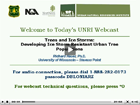Urban Forests – Effects – Air Quality
Effects of Urban Forests on air Quality
UNRI scientists are using structural data to determine the effects of urban forest on air quality, water quality, building energy use, urban climate, ultraviolet radiation, etc. Urban vegetation can directly and indirectly affect local and regional air quality by altering the urban atmospheric environment. UNRI scientists have found that the four main ways that urban trees affect air quality area include:
- Temperature reduction and other microclimatic effects
- Removal of air pollutants
- Emission of volatile organic compounds and tree maintenance emissions
- Energy effects on buildings
Temperature Reduction
Tree transpiration and tree canopies affect air temperature, radiation
absorption and heat storage, wind speed, relative humidity, turbulence, surface albedo, surface roughness and consequently the evolution of the mixing-layer height.
Removal of Air Pollutants
Trees remove gaseous air pollution primarily by uptake via leaf stomata, though some gases are removed by the plant surface.
Emission of Volatile Organic Compounds (VOCs)
Emissions of volatile organic compounds by trees can contribute to the formation of ozone and carbon monoxide. However, in atmospheres with low nitrogen oxide concentrations (e.g., some rural environments), VOCs may actually remove ozone.
Energy Effects on Buildings
Trees reduce building energy use by lowering temperatures and shading buildings during the summer, and blocking winds in winter.
Please visit the Syracuse Research Unit for detailed information on the air quality research that is being undertaken by the UNRI research team and their cooperating partners.


